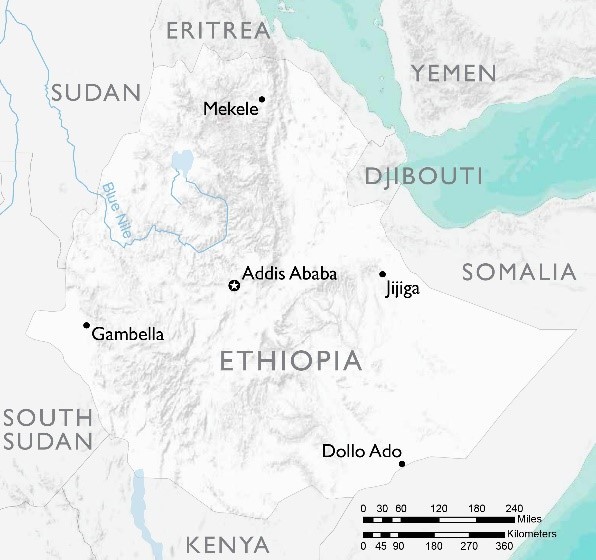- What We Do
- Agriculture and Food Security
- Democracy, Human Rights and Governance
- Economic Growth and Trade
- Education
- Ending Extreme Poverty
- Environment and Global Climate Change
- Gender Equality and Women's Empowerment
- Global Health
- Water and Sanitation
- Working in Crises and Conflict
- U.S. Global Development Lab

September 5, 2017
Food Security Situation
-
Due to the lingering effects of the 2015-2016 El Niño-induced drought and poor October-to-December 2016 and March-to-June 2017 rainy seasons, an estimated 8.5 million people in Ethiopia require relief food assistance, according to the UN Office for the Coordination of Humanitarian Affairs (OCHA). This is in addition to 8 million chronically food-insecure people who receive food or cash assistance through the Government of Ethiopia (GoE)-led Productive Safety Net Program (PSNP).
-
Large areas of southeastern Ethiopia will continue to face Emergency (IPC Phase 4) acute food insecurity through early 2018, with some of the worst-affected households expected to move into Catastrophe (IPC Phase 5), according to the Famine Early Warning Systems Network.* Urgent and sustained humanitarian assistance in southeastern Ethiopia is needed to mitigate very high levels of acute malnutrition and the threat of loss of life.
-
The drought in Somalia and conflict in Sudan, Somalia, South Sudan and Eritrea have resulted in an influx of refugees into Ethiopia, which hosts more than 838,000 refugees in total. Approximately 35,000 new South Sudanese refugees have arrived in Ethiopia since January 2017, bringing the total to more than 379,000 South Sudanese refugees in Ethiopia.
Food Assistance Programs
- In partnership with Catholic Relief Services (CRS), Food for the Hungry (FH), Relief Society of Tigray (REST) and World Vision (WV), the USAID Office of Food for Peace (FFP) targets food-insecure Ethiopians with long-term development interventions through the PSNP to reduce chronic food insecurity. PSNP is also the first line of response in targeted areas during any food security crisis. With an annual contribution to the PSNP of approximately $110 million, FFP addresses the basic food needs of approximately 1.3 million chronically food-insecure people through the regular seasonal transfer of food and cash resources, while supporting the creation of assets that generate economic benefit to the communities as a whole.
-
FFP partners with the UN World Food Program (WFP) and CRS to provide relief food assistance that saves lives and reduces human suffering of those affected by climatic and other shocks, as well as contributes to meeting the basic energy requirements of refugees. In addition, FFP provides specialized nutrition commodities for the treatment of acute malnutrition to WFP, UN Children's Fund (UNICEF) and the USAID Office of U.S. Foreign Disaster Assistance’s health and nutrition partners. In Fiscal Year 2017, FFP is also providing resources to WFP for local and regional procurement of cereals, pulses and specialized nutritional foods.
Total Contributions:
| U.S. Dollars | Metric Tons | |
|---|---|---|
|
Fiscal Year 2017 |
$325.5 million | 517,615 MT |
| Fiscal Year 2016 |
$514.6 million |
789,208 MT |
| Fiscal Year 2015 | $241.3 million | 328,150 MT |
*The Integrated Food Security Phase Classification (IPC) is a standardized tool that aims to classify the magnitude and severity of food insecurity. The IPC scale, which is comparable across countries, ranges from Minimal (IPC 1) to Famine (IPC 5). A Famine classification applies to a wider geographical location, while the term Catastrophe (IPC 5) refers to an extreme lack of food at the household level even with full employment of coping strategies. Famine is determined when more than 20 percent of households in an area are classified as experiencing Catastrophe, when the global acute malnutrition (GAM) level exceeds 30 percent, and when the crude mortality rate exceeds two people per 10,000 persons per day.
Related Resources
Final Ethiopia FY 2016 Country Specific Information
Ethiopia Country Development Cooperation Strategy 2011-2015
Climate Variability and Change in Ethiopia - Summary Findings
Ethiopia Bellmon Analysis 2015/16 and Reassessment of Crop Production and Marketing for 2014/15
Food Security Country Framework - Ethiopia
Productive Safety Net Program Phase IV Program Implementation Manual
Productive Safety Net Program Phase IV - Capacity Development Strategy
Examples of Collaboration Indicators for Ethiopia DFAP Applicants – RISE Workshop
Feed the Future Ethiopia Fact Sheet
Multi-Year Annual Program Statement for a Rapid Response Nutrition and WASH Program in Ethiopia
(Re)assessing the Relationship Between Food Aid and Armed Conflict [PDF, 171 KB]







Comment
Make a general inquiry or suggest an improvement.